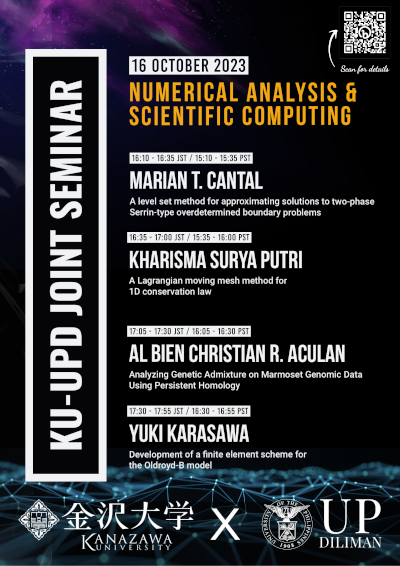KU-UPD Joint Seminar on Numerical Analysis and Scientific Computing

We are inviting everyone to the first ever online joint seminar on Numerical Analysis and Scientific Computing on Monday, October 16, 2023, 3-5 PM (Philippine time). This is organized by Kanazawa University (KU), Japan and the Institute of Mathematics of UP Diliman (UPD). The seminar will feature Marian Cantal and Al Bien Christian Aculan (graduate students from UPD) and Kharisma Surya Putri and Yuki Karasawa (graduate students from KU).
Marian Cantal (Institute of Mathematics, University of the Philippines Diliman)
Title: A level set method for approximating solutions to two-phase Serrin-type overdetermined boundary problems
Abstract: We consider an overdetermined problem of Serrin-type with respect to an operator in divergence form with piecewise constant coefficients subject to both Dirichlet and Neumann conditions on the free boundary. These problems appear in solid mechanics where the goal is to find the best shape of a cylindrical bar made of two different isotropic materials. A recent result by Cavallina and Yachimura asserts that if a fixed core is sufficiently close to a ball, then the two-phase Serrin-type problem admits a solution with a domain sufficiently close to a ball. In this work, we develop a level set method for approximating the solution to a two-phase Serrin-type overdetermined boundary problem based on the Osher-Sethian formulation and the boundary variation algorithm for shape optimization employing gradient descent of a Kohn-Vogelius-type functional. The implicit nature of the proposed method naturally handles topological changes and eliminates the need for numerical surgeries to handle mesh-related issues. Moreover, we present our computational examples that are consistent with those of Cavallina and Yachimura.
Kharisma Surya Putri (Division of Mathematical and Physical Sciences, Kanazawa University)
Title: A Lagrangian moving mesh method for 1D conservation law
Abstract: Various numerical methods have been proposed to deal with convection-diffusion problems, a suitable one being the Lagrange–Galerkin (LG) finite element method. However, LG schemes with fixed mesh appear to have limitations when capturing high-concentration phenomena, which give rise to sharp spike patterns. In these circumstances, LG schemes can produce a numerical oscillating solution. In this talk, we present a Lagrangian moving mesh scheme for scalar conservation laws in order to capture such sharp spike patterns accurately. The content of this talk is based on joint work with T. Mizuochi, N. Kolbe, and H. Notsu.
Al Bien Christian Aculan (Institute of Mathematics, University of the Philippines Diliman)
Title: Analyzing Genetic Admixture on Marmoset Genomic Data Using Persistent Homology
Abstract: Admixture analysis is a method to infer an individual’s origins based on genetic ancestry. It aims to identify two or more previously isolated populations that interbred in the individual’s ancestors. The recent availability of genome-wide high-density single nucleotide polymorphisms (SNPs) data has facilitated the study of admixture in humans. Admixture algorithms use statistical methods and are computationally intensive. In this study, we use persistent homology to analyze admixture in a population of captive marmosets. Persistent homology (PH) is an applied mathematics tool that is attractive to mathematicians and computer scientists due to its foundations in algebraic topology, linear algebra and computer science. It can be used to analyze complex multi-dimensional data. It does so by identifying fundamental structures in the data through persistence diagrams and barcodes – objects that summarizes the topological structure of data. We use persistent homology to analyze phased SNP data obtained from whole genome sequencing of 123 marmosets.
Using a computational pipeline based on persistent homology, we show that admixed datasets generally admit higher values related to their barcodes and persistence diagrams (PDs), particularly in birth and death times and number of cycles in their persistence diagrams. Furthermore, we employ bottleneck and Wasserstein distances, which are metrics on persistence diagrams, to differentiate PDs of admixed and non-admixed datasets. Results show that chromosome 10 has the most differentiation in its PDs. Additionally, we compared distances of PDs of the same class (admixed/non-admixed), which were then plotted to heatmaps for visualization. Heatmaps showed clearer dissimilarity of PDs using the Wasserstein metric.
Yuki Karasawa (Division of Mathematical and Physical Sciences, Kanazawa University)
Title: Development of a finite element scheme for the Oldroyd-B model
Abstract: In devising numerical schemes for viscoelastic fluid flow models, one of the key issues is how to approximate the upper-convected time derivative (UCTD) term. Recently, a temporal second-order approximation of the UCTD has been proposed and implemented in a finite difference framework [D.O. Medeiros et al., SIAM J. Numer. Anal., 2021]. In this talk, we extend the idea and propose a finite element scheme. This is joint work with D.O. Medeiros, T. Nakazawa, C.M. Oishi, and H. Notsu.
For more information, you may visit the website for this joint event.
